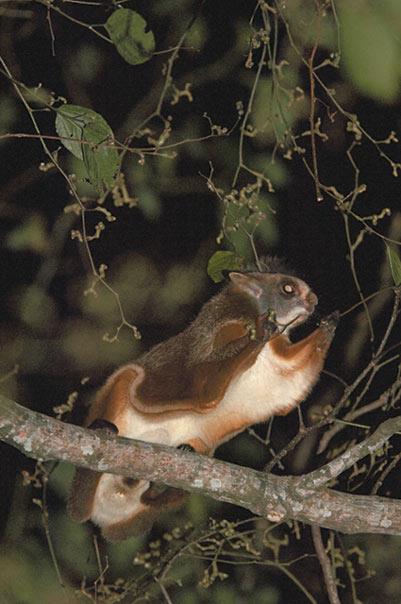1. Namdapha Flying Squirrel Habitat: Endemic to Namdapha National Park,Arunachal Pradesh This beautiful and extremely rare rodent
2. Pygmy Hog
Habitat: Manas National Park, Assam
This little pig’s really tiny—all of 71cm long and 30cm tall. Once it used to occur all over eastern India, Nepal and Bhutan, but now it can be viewed only in Assam, specifically Manas. It occurs in the tall, wet grasslands of the terai.
3. Mouse Deer
Habitat: Southern India, especiallyTamil Nadu and Kerala
Native to India, although there have been reports of it from Nepal as well, the small spotted deer measures about 58cm in length and weighs just three kilograms. There have been periodic sightings from South India, especially in Tamil Nadu and Kerala. The Kalakkad-
Mundanthurai Tiger Reserve is the best place to see them, along with other sanctuaries in the Western Ghats.
4. Nilgiri Marten
Habitat: Western Ghats
A close cousin of the commonly viewed yellow-throated marten, the rarer Nilgiri marten is larger and has a distinctively bright throat ranging from yellow to orange. It is endemic to the Western Ghats, occurring over six or so national parks.
5. Astor Markhor
Habitat: Pir Panjal range, Jammu & Kashmir
The Markhor is a stunning animal found mostly in the Afghan highlands and in the Karakoram valleys in Pakistan. However, one branch of this corkscrew-horned animal, the Astor Markhor, can be found in the Indian Himalaya, especially in the Pir Panjal range in Kashmir.
6. Gee’s Golden Langur
Habitat: Upper and western Assam, Kokrajhar and Manas National Park
This golden langur is one of the most beautiful primate species found in the country. It occurs in a forested belt stretching from the Manas river in Assam to the foothills of southern Bhutan.
7. Kashmir Stag
Habitat: Dachigam National Park, Kashmir
A magnificent sub-species of the European Red Deer, the state animal of Jammu & Kashmir is also a highly endangered one. Centuries of hunting and poaching have taken their toll on it. Now seen almost exclusively in the Dachigam National Park, only around 150 of these stags (also called hangul) are known to exist in the wild.
8. Hispid Hare
Habitat: Terai grasslands, fromUttar Pradesh to Assam
Despite the wide spread, this shy animal is difficult to spot because of the tall grasslands it inhabits. Also called the Assam rabbit, it occurs in broken stretches across northern India and can be found in places like Jaldapara, Manas and Kanha.
9. Wild Water Buffalo
Habitat: Kaziranga, Manas and Dibru-Saikhowa national parks
Although a close cousin of the domesticated buffalo, these wild water buffalos are very different beasts in terms of size and ferocity. They can be commonly seen in the high grasslands of the terai and besides large rivers like the Brahmaputra. Kaziranga National Park boasts a large population.
10. Indian Red Panda
Habitat: Sikkim and Meghalaya
After its discovery in the early nineteenth century, this small omnivorous mammal has been much loved for its adorable good looks. Found between the Annapurna Range in Nepal and Myanmar in the east, in India it can be seen in the forests of Sikkim as well as in Meghalaya in places like the Balpakram National Park.
11. Jerdon’s Courser
Habitat: Eastern Ghats in Andhra Pradesh, specifically Sri Lankamalleshwara Sanctuary
This compact courser with two distinctive brown breast-bands is a critically endangered species endemic to India. It’s found principally in Andhra Pradesh south of the Godavari, and was long thought extinct before being rediscovered in 1986.
12. Sangai
Habitat: Swamplands of Manipur near Loktak lake
This impressive brow-antlered deer (also called Eld’s Deer) is found almost exclusively in the swampy forests of the Keibul Lamjao National Park in Manipur. Hunted widely in the past for its distinctive asymmetrical antlers, the sangai is also much celebrated in Manipuri folklore.
13. Bengal Florican
Habitat: Terai grasslands; especially Kaziranga
This critically endangered bird is also known as the Bengal Bustard. A striking bird with jet-black plumage and a rakish crest on its head, it is thought to be almost extinct, although there have been some recent sightings in Kaziranga.
14. Narcondam Hornbill
Habitat: Narcondam Island
A strikingly colourful hornbill, this bird has one of the smallest geographical spreads in the world, being restricted exclusively to the island of Narcondam in the Andaman Sea. The male and female birds have dramatically different plumages.
15. Bugun Liocichla
Habitat: Eaglenest Wildlife Sanctuary, Arunachal Pradesh
A small colourful bird of the babbler family, the liocichla is a recent discovery. It was spotted for the first time in the wild in 1995, then a decade later in 2006, and subsequently catalogued as a new species. It occurs at an altitude of 2,000m and has only ever been spotted inside the Eaglenest sanctuary.
Leave a Reply
You must be logged in to post a comment.


